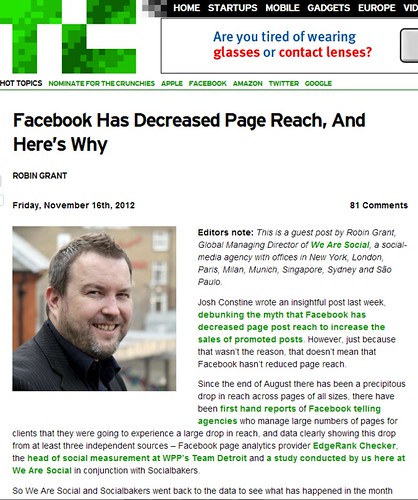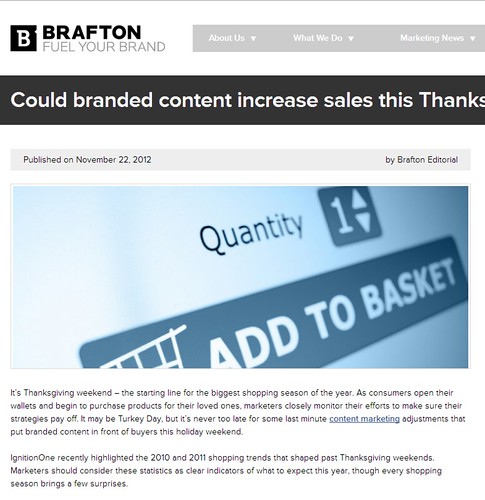 News on Facebook Marketing, according to HubSpot : Facebook will soon roll out ROI tracking tool, a new feature test allowing advertisers to track the actions of Facebook users post-click. Thus, helping advertisers to track conversions to their external pages and also allows businesses to follow their success on Facebook.
News on Facebook Marketing, according to HubSpot : Facebook will soon roll out ROI tracking tool, a new feature test allowing advertisers to track the actions of Facebook users post-click. Thus, helping advertisers to track conversions to their external pages and also allows businesses to follow their success on Facebook.
For Facebook’s ROI tracking tool to work, all advertisers will need to do is place code on pages on their website that users access after making a conversion. The Facebook ads platform is alerted that someone who viewed and clicked on a Facebook ad has converted off-site on the advertiser’s page once a Facebook user views this page.
Advertisers can also optimize their campaigns for better results with the optimized CPM (cost per thousand impressions) bidding tool. This tool allows advertisers to tell Facebook their goal, and Facebook will adjust the CPM of ads based on the current demand. Constant changing of the price will no longer be a worry for advertiser’s using the optimized CPM tool as Facebook will now do it for them.
Instead of relying on a third party company to track success and ROI, using a tracking tool will allow advertisers to use the Facebook platform for all aspects of the campaign. Tracking the number of conversions, including sales, leads, or downloads, allow advertisers to measure if their Facebook campaigns are working and what they can do to optimize their campaigns for better results, if it is not working.
Advertisers who are not able to see the return on investment of their Facebook ads can benefit from this conversion tool, when used along with the CPM tool. Although identifying information about a user will not be provided by the tool, it will supply information long after someone views an ad.
Read more at Facebook to Launch ROI Tracking Tool for Ads
 News on Facebook Marketing, according to TechCrunch: Data’s from at least three independent sources – Facebook’s EdgeRank Checker, WPP’s Team Detroit head of social measurement and a study conducted here at We Are Social and Socialbakers – shows that there has been an abrupt decreased page post reach on Facebook to increase the sales of promoted posts since the end of August.
News on Facebook Marketing, according to TechCrunch: Data’s from at least three independent sources – Facebook’s EdgeRank Checker, WPP’s Team Detroit head of social measurement and a study conducted here at We Are Social and Socialbakers – shows that there has been an abrupt decreased page post reach on Facebook to increase the sales of promoted posts since the end of August.
The study conducted here at We Are Social and Socialbakers shows a clear drop by over 40% on the average post’s organic reach since the end of August.
A follow-up study released by EdgeRank Checker also reveals a huge drop in reach from September to October, drilling down into the average reach of different post types. Their data’s also shows that plain status update posts don’t seem to be affected by the reach drop as photo, video or link updates.
However, our study shows that the average page post engagement rate has stayed fairly steady during the period despite the drop in reach, meaning that the posts that are seen by fans are now getting more engagement.
This drop in Facebook page reach since the end of August has been going on for over two months and Facebook have changed their EdgeRank algorithm to reduce the amount of brands’ Facebook page posts seen in fans’ newsfeeds.
Some say that this move by Facebook is to force page owners to pay for reach using promoted posts. However, other say that this is to compensate for the growing number of pages that its users are fans of, and the increased number of posts coming from those pages.
Read more at Facebook Has Decreased Page Reach, And Here’s Why
 News on Social Marketing, according to Brafton: as consumers open their wallets and begin to purchase products for their loved ones, marketers should consider statistics of the past Thanksgiving weekend as indicators of what to expect on this year’s holiday weekend.
News on Social Marketing, according to Brafton: as consumers open their wallets and begin to purchase products for their loved ones, marketers should consider statistics of the past Thanksgiving weekend as indicators of what to expect on this year’s holiday weekend.
The shopping trends of the 2010 and 2011 Thanksgiving weekends were recently emphasized by IgnitionOne. In 2011, the largest sale occurred on Cyber Monday and was considered the biggest online shopping day in history when a $1.25 billion in sales was recorded. Fifty percent of those sales came from professionals purchasing goods at work.
For the Thanksgiving weekend, 2010 showed a $45 billion in sales. But according to CNN, retailers calculated $52.4 billion in 2011, a 16 percent year-over-year increase. Also, in 2012, 226 million consumers shopped online compared to 212 million in 2011.
According to IBM’s Cyber Monday Benchmark Report, sales increased 33 percent in 2011 from the previous year when looking at Cyber Monday specifically. A 115 percent increase year-over-year on social chatter was also recorded leading up to the day.
To encourage an increase in sales this year, the best way is for online marketers to develop custom content that sparks social chatter as consumers spend more time discussing trends through social media before they buy. Cyber Monday remains an invaluable date for brands that want to significantly increase profit margins.
Read more at Could branded content increase sales this Thanksgiving weekend?
Other Social Marketing Articles of Interest
Google Beats In Q2 2012: Revenue Up 35 Percent To $12.21B, $2.79B In Net Income
Black Friday Stats: Mobile Impresses While Social Depresses
